
The Royal Australian Air Force (RAAF) is the principal aerial warfare force of Australia, a part of the Australian Defence Force (ADF) along with the Royal Australian Navy and the Australian Army. Constitutionally the Governor-General of Australia is the de jure Commander-in-Chief of the Australian Defence Force. The Royal Australian Air Force is commanded by the Chief of Air Force (CAF), who is subordinate to the Chief of the Defence Force (CDF). The CAF is also directly responsible to the Minister for Defence, with the Department of Defence administering the ADF and the Air Force.
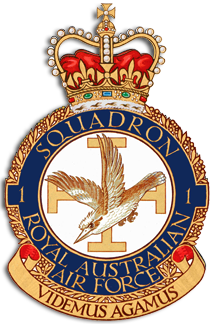
No. 1 Squadron is a Royal Australian Air Force (RAAF) squadron headquartered at RAAF Base Amberley, Queensland. It is controlled by No. 82 Wing, part of Air Combat Group, and is equipped with Boeing F/A-18F Super Hornet multi-role fighters.
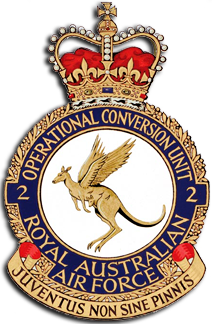
No. 2 Operational Conversion Unit is a fighter training unit of the Royal Australian Air Force (RAAF). Located at RAAF Base Williamtown, New South Wales, the unit trains pilots to operate the Lockheed Martin F-35 Lightning II. Pilots new to the F-35 enter No. 2 2OCU after first qualifying to fly fast jets at No. 79 Squadron and undertaking initial fighter combat instruction at No. 76 Squadron. Once qualified on the F-35, they are posted to one of No. 81 Wing's operational F-35 units, No. 3 Squadron, No. 75 Squadron or No. 77 Squadron.
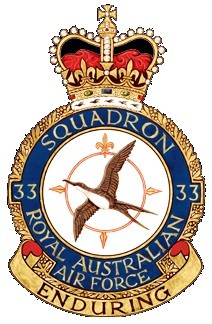
No. 33 Squadron is a Royal Australian Air Force (RAAF) strategic transport and air-to-air refuelling squadron. It operates Airbus KC-30A Multi Role Tanker Transports from RAAF Base Amberley, Queensland. The squadron was formed in February 1942 for service during World War II, operating Short Empire flying boats and a variety of smaller aircraft. By 1944 it had completely re-equipped with Douglas C-47 Dakota transports, which it flew in New Guinea prior to disbanding in May 1946.

The Royal Australian Air Force's Air Combat Group (ACG) is the group which administers the RAAF's fighter and bomber aircraft. ACG was formed on 7 February 2002 by merging the RAAF's Tactical Fighter Group and Strike Reconnaissance Group in an attempt to improve the speed with which the RAAF can deploy its combat aircraft.

No. 78 Wing is a Royal Australian Air Force (RAAF) operational training wing, headquartered at RAAF Base Williamtown, New South Wales. It comprises Nos. 76 and 79 Squadrons, operating the BAE Hawk 127 lead-in fighter, and No. 278 Squadron, a technical training unit. No. 79 Squadron, located at RAAF Base Pearce, Western Australia, is responsible for converting new pilots to fast jets, while No. 76 Squadron at Williamtown conducts introductory fighter courses; both units also fly support missions for the Royal Australian Navy and the Australian Army.

No. 81 Wing is responsible for operating the Lockheed Martin F-35 Lightning II multi-role fighters of the Royal Australian Air Force (RAAF). Headquartered at RAAF Base Williamtown, New South Wales, the wing comprises three combat units, Nos. 3 and 77 Squadrons based at Williamtown and No. 75 Squadron at RAAF Base Tindal, Northern Territory, as well as an operational conversion unit at Williamtown. No. 81 Wing headquarters oversees squadron training in air-to-air and air-to-ground tactics, and support for the Australian Army and Royal Australian Navy. Tasked with offensive and defensive counter-air operations, the Hornets have been deployed to Diego Garcia in 2001–02, when they provided local air defence, to Iraq in 2003, when they saw action flying fighter escort and close air support missions in concert with Coalition forces, and to the Middle East in 2015–16, when they undertook strike operations during the military intervention against ISIL. They have also been employed to patrol high-profile events in Australia, including the Commonwealth Games and visits by foreign dignitaries.

No. 82 Wing is the strike and reconnaissance wing of the Royal Australian Air Force (RAAF). It is headquartered at RAAF Base Amberley, Queensland. Coming under the control of Air Combat Group, the wing operates F/A-18F Super Hornet multirole fighters, EA-18G Growler electronic warfare aircraft, and Pilatus PC-21 forward air control aircraft. Its units include Nos. 1 and 6 Squadrons, operating the Super Hornet and Growler respectively, as well as No. 4 Squadron, operating the PC-21.
Air Vice Marshal Alfred John Quaife, AM is a retired senior officer of the Royal Australian Air Force (RAAF).
Air Marshal Raymond George (Ray) Funnell, is a retired senior commander of the Royal Australian Air Force (RAAF). He served as Chief of the Air Staff (CAS) from 1987 until 1992. A graduate of RAAF College, he began his career flying CAC Sabre jet fighters in Australia and South East Asia in the 1950s and 1960s. From 1972 to 1975 he commanded No. 6 Squadron, during which time the General Dynamics F-111C swing-wing bomber entered Australian service. He held senior staff posts in the early 1980s. In 1986, he was promoted to air marshal and became the inaugural Vice Chief of the Defence Force. Appointed CAS in July 1987, Funnell was closely involved in the development and dissemination of air power doctrine. He retired from the RAAF in October 1992 following his term as CAS, and was founding Principal of the Australian College of Defence and Strategic Studies from 1994 to 1998. Since then he has served on various Federal Government committees on immigration and detention.

RAAF Base Amberley is a Royal Australian Air Force (RAAF) military airbase located 8 km (5.0 mi) southwest of Ipswich, Queensland in Australia and 50 km (31 mi) southwest of Brisbane CBD. It is currently home to No. 1 Squadron, No. 6 Squadron, No. 33 Squadron, No. 35 Squadron and No. 36 Squadron. Amberley is also home to Army units making up the 9th Force Support Battalion. Located on 1,600 hectares, RAAF Amberley is the largest operational base in the RAAF, employing over 5,000 uniformed and civilian personnel. There are a variety of other formations on the base such as training colleges and maintenance areas. Amberley's largest squadron in terms of personnel is No. 382 Expeditionary Combat Support Squadron RAAF (ECSS) providing both garrison and deployed combat support. Amberley was one of only two airfields in Australia that were listed as a Transoceanic Abort (TOA) landing site for the Space Shuttle. Amberley is currently undergoing a A$64 million dollar re-development program. The RAAF has plans to have Amberley operating as its "superbase" with flights of F/A-18F Super Hornets, KC-30A, C-17 Globemaster and the C-27J Spartan.

Air Marshal Melvin Ernest Glanville Hupfeld, is a retired senior officer of the Royal Australian Air Force. He served as Air Commander Australia from 2012 to 2014 and was the acting and final Chief Capability Development Group (2015–16), before being appointed as Head Force Design in the Vice Chief of the Defence Force Group (2016–18). He was promoted air marshal and made Chief of Joint Operations in May 2018, and succeeded Air Marshal Leo Davies as Chief of Air Force in July 2019.

Operation Okra is the Australian Defence Force (ADF) contribution to the military intervention against the Islamic State. The force is part of Joint Task Force 633 in the Middle East. The operation commenced on 31 August 2014, and its initial stated aim was to combat ISIL threats in Iraq. In September 2015, the Australian airstrikes were extended to Syria. In June 2017, flights in Syria were temporarily halted in response to American forces shooting down a Syrian Air Force jet, before later being resumed.

Air Marshal Gavin Neil "Leo" Davies, is a retired senior officer of the Royal Australian Air Force (RAAF). A navigator who retrained as a pilot, he joined the RAAF in 1979, commanded No. 1 Squadron RAAF (2002–03) and No. 82 Wing RAAF (2004–05), deployed to Iraq in 2007, and was Australia's air attaché in Washington, D.C. (2010–11). He served as Deputy Chief of Air Force from 2012 to 2015 and succeeded Air Marshal Geoff Brown as Chief of Air Force, the professional head of the RAAF, in July 2015. He retired from the RAAF in July 2019.
Air Vice Marshal Gavin Alexander Turnbull, is a retired senior commander in the Royal Australian Air Force (RAAF). He joined the RAAF in 1984, trained as a helicopter pilot, and transferred to fast jets in 1991. He has commanded No. 77 Squadron RAAF (2002–04), No. 81 Wing RAAF (2007–11) and the 609th Combined Air Operations Centre (2012), and deployed on operations to the Sinai Peninsula, Iraq and Afghanistan. He served as Air Commander Australia from 2014 to 2017, and Deputy Chief of Air Force from May 2017 to July 2019.
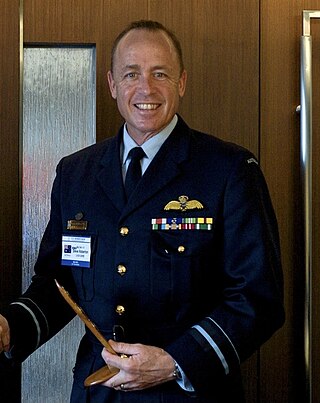
Air Vice Marshal Steven Peter "Zed" Roberton, is a retired senior commander of the Royal Australian Air Force (RAAF). He joined the RAAF in 1989 and trained as a fighter pilot. He has deployed to Iraq, commanded No. 75 Squadron RAAF (2003–06) and No. 82 Wing RAAF (2010–11), and led Air Task Group 630 on operations against the Islamic State of Iraq and the Levant (2014–15). He served as commander Air Combat Group RAAF from 2015 to 2017, Air Commander Australia from 2017 to 2019, and Head Force Design within the Vice Chief of Defence Force Group from June 2019 to February 2022.
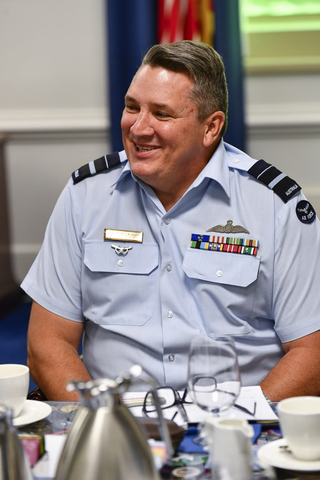
Air Vice Marshal Stephen Leslie Meredith, is a retired senior officer of the Royal Australian Air Force (RAAF). He joined the RAAF as a navigator in 1986. He has commanded No. 6 Squadron RAAF (2006–08), No. 42 Wing RAAF (2008–10), the Aerospace Operational Support Group RAAF (2014–16) and the Combined Air Operations Centre (2017), and has served on operations in the Gulf War, War in Afghanistan and in the International military intervention against ISIL. He served as Head Force Integration from 2017 to 2019, before being appointed Deputy Chief of Air Force from July 2019 to January 2023.

Air Marshal Robert Timothy Chipman, is a senior officer in the Royal Australian Air Force (RAAF) who serves as Chief of Air Force since July 2022. He joined the RAAF as an aeronautical engineer in 1989 and gained his pilot's wings in 1994. He has commanded No. 75 Squadron RAAF (2006–09), the Air and Space Operations Centre (2010–12), No. 81 Wing RAAF (2013–14) and Air Task Unit 630.1 (2014), and deployed to the Middle East on Operations Slipper and Okra. He served as the Australian Military Representative to NATO and the European Union from 2019 to 2021 and Head Military Strategic Commitments from 2021 to 2022. He succeeded Air Marshal Mel Hupfeld as Chief of Air Force on 1 July 2022. Chipman will be appointed Vice Chief of the Defence Force in July 2024.
Air Vice-Marshal Stephen Gareth Chappell, is a senior officer in the Royal Australian Air Force (RAAF), serving as Head Military Strategic Commitments since July 2022. He joined the RAAF through the Australian Defence Force Academy in 1993 and gained his pilot's wings in 1998. He has deployed on Operations Falconer and Okra to Iraq, and has commanded No. 1 Squadron RAAF (2013–16) and No. 82 Wing RAAF (2018–20). He is to be appointed Chief of Air Force in July 2024.

Air Marshal Darren James Goldie, is a senior officer in the Royal Australian Air Force. He joined the RAAF through the Australian Defence Force Academy in 1993 and gained his pilot's wings in 1997. He has deployed on operations to East Timor, Iraq and Afghanistan, and has commanded No. 37 Squadron RAAF (2012–15) and No. 92 Wing RAAF (2017–18). He was Air Commander Australia from April 2022 to June 2023, and served as the inaugural National Cyber Security Coordinator from July to November 2023.
















